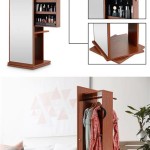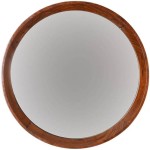Does a Convex Mirror Make Things Bigger?
Convex mirrors, characterized by their outward curvature, offer a unique perspective compared to flat or concave mirrors. They are commonly used in various settings, from security surveillance to vehicle side mirrors, due to their wide field of view. However, understanding how they affect the size of reflected images is crucial for their effective application.
Key Points about Convex Mirrors and Image Size:
- Convex mirrors always produce virtual images.
- Virtual images formed by convex mirrors are always smaller than the object.
- The image is located behind the mirror's surface.
Contrary to the magnifying effect of some mirrors, convex mirrors create images that appear smaller than the original objects. This diminishing effect stems from the diverging nature of light reflection on a convex surface. As light rays strike the outward curve, they spread outwards upon reflection. When these diverging rays are extended backward, they appear to converge behind the mirror, forming a virtual image.
Understanding Virtual Images:
- Virtual images cannot be projected onto a screen.
- They appear to be located where the reflected light rays seem to originate.
- In the case of convex mirrors, this location is behind the mirror's surface.
The virtual image formed by a convex mirror not only appears smaller but also appears closer to the mirror than the actual object. This phenomenon is due to the perceived distance of the virtual image's location – behind the mirror's surface. This combination of reduced size and seemingly reduced distance contributes to the wide field of view that convex mirrors provide.
The Wide Field of View Advantage:
- The smaller virtual image allows a broader area to be reflected within the mirror's frame.
- This is essential for applications like security monitoring and driver side mirrors.
Consider a security mirror in a shop. Its convex shape allows store personnel to observe a larger area of the store than a flat mirror of the same size would allow. Similarly, the passenger-side mirror of a car, typically convex, provides the driver with a broader view of the adjacent lane, enhancing safety. This increased field of view comes at the cost of image size, as objects appear smaller and farther away than they actually are. The phrase "objects in mirror are closer than they appear" printed on passenger-side mirrors serves as a crucial reminder of this distortion.
Comparing Convex Mirrors to Other Mirror Types:
- Concave mirrors can produce magnified images depending on the object's position.
- Flat mirrors produce images of the same size as the object.
- Convex mirrors always produce smaller images.
Unlike concave mirrors, which can produce both real and virtual images depending on the object's distance from the mirror, convex mirrors consistently create virtual, diminished images regardless of the object's placement. This predictable behavior makes them suitable for applications where a wider field of view, even at the expense of magnification, is prioritized. Flat mirrors, offering a 1:1 size representation, lack the expanded view provided by convex mirrors.
Practical Applications of Convex Mirrors' Diminishing Effect:
- Security monitoring in stores and public areas.
- Vehicle side mirrors for enhanced visibility of adjacent lanes.
- Roadway mirrors at blind corners to improve traffic safety.
The shrinking effect of convex mirrors, though resulting in smaller images, is advantageous in specific situations. For instance, in a retail setting, a broader view allows for better surveillance against shoplifting. On the roads, convex mirrors placed at blind corners or intersections enable drivers to see oncoming traffic more effectively. This broadened perspective increases safety by mitigating potential collisions. While the objects appear smaller in these mirrors, the enhanced field of vision ultimately contributes to a more comprehensive understanding of the surroundings.
The Physics Behind the Diminished Image:
- Diverging reflection of light rays from the convex surface.
- Apparent convergence of reflected rays behind the mirror.
- Formation of a virtual image smaller than the original object.
The fundamental principle behind the diminished image in convex mirrors lies in the behavior of light interacting with the curved surface. The outward curvature causes incident light rays to reflect outwards, diverging away from each other. The human eye, however, interprets these diverging rays as if they were originating from a point behind the mirror's surface. This perceived point of origin is where the virtual image appears. Due to the spreading of the reflected light, the virtual image formed is always smaller than the original object.
How Do Reflections From Convex Mirrors Make Objects Appear Smaller Quora

Convex Mirrors And Objects Larger Than The Mirror

Convex Mirrors And Objects Larger Than The Mirror
Objects In The Mirror Are Actually Images Article Khan Academy
Why Does The Car Side Mirror Display Objects Appear Further Than They Are Not Just Make As Quora
Objects In The Mirror Are Actually Images Article Khan Academy

Why Objects In The Mirror Are Closer Than They Appear Science Abc
Can A Convex Mirror Form Magnified Image Quora

Things To Consider While Choosing The Right Convex Mirror

Why Do I Look Diffe In Mirrors 5 Common Reasons








